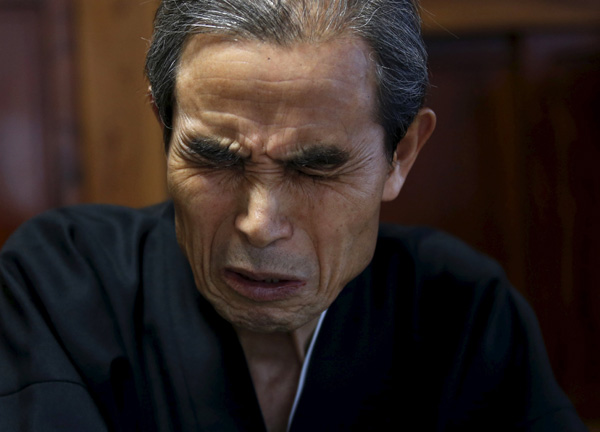Japan's nuclear refugees face bleak return 5 years after Fukushima
(Agencies) Updated: 2016-03-03 09:51
|
 |
|
Tokuo Hayakawa, a 76-year-old Buddhist priest who returned to his 600-year-old family temple in Naraha in September 2015 when the evacuation order was lifted, reacts as he speaks during an interview with Reuters at his home in Naraha, Fukushima prefecture, Japan, February 11, 2016. Picture taken February 11, 2016. [Photo/Agencies] |
NARAHA - Tokuo Hayakawa carries a dosimeter around with him at his 600-year-old temple in Naraha, the first town in the Fukushima "exclusion zone" to fully reopen since Japan's March 2011 catastrophe. Badges declaring "No to nuclear power" adorn his black Buddhist robe.
Hayakawa is one of the few residents to return to this agricultural town since it began welcoming back nuclear refugees five months ago.
The town, at the edge of a 20-km (12.5 mile) evacuation zone around the crippled Fukushima Daiichi plant, was supposed to be a model of reconstruction.
Five years ago, one of the biggest earthquakes in history shook the country's northeast. The 10-metre (33-foot) tsunami it spawned smashed into the power plant on the Fukushima coastline triggering a meltdown and forcing nearby towns to evacuate. The disaster killed over 19,000 people across Japan and caused an estimated 16.9 trillion yen ($150 billion) in damages.
Only 440 of Naraha's pre-disaster population 8,042 have returned - nearly 70 percent of them over 60.
"This region will definitely go extinct," said the 76-year-old Hayakawa.
He says he can't grow food because he fears the rice paddies are still contaminated. Large plastic bags filled with radioactive topsoil and detritus dot the abandoned fields.
With few rituals to perform at the temple, Hayakawa devotes his energies campaigning against nuclear power in Japan. Its 54 reactors supplied over 30 percent of the nation's energy needs before the disaster. Today, only three units are back in operation after a long shutdown following the nuclear meltdown in Fukushima. Others are looking to restart.
"I can't tell my grandson to be my heir," said Hayakawa, pointing at a photo of his now-teenaged grandson entering the temple in a full protective suit after the disaster.
"Reviving this town is impossible," he said. "I came back to see it to its death."
That is bound to disappoint Japan's Prime Minister Shinzo Abe. Rebuilding Naraha and other towns in the devastated northeast, he says, is crucial to reviving Japan.
Tokyo pledged 26.3 trillion ($232 billion) over five years to rebuild the disaster area and will allocate another 6 trillion for the next five years.
VANISHING TOWN
More than 160,000 people were evacuated from towns around the Daiichi nuclear plant. Around 10 percent still live in temporary housing across Fukushima prefecture. Most have settled outside their hometowns and have begun new lives.
In Naraha, two restaurants, a supermarket and a post office, housed in prefabricated shacks, make up the town's main shopping centre. The restaurants close at 3 p.m.
No children were in sight at Naraha's main park overlooking the Pacific Ocean on a recent morning. Several elderly residents were at the boardwalk gazing at hundreds of bags stuffed with radioactive waste.
In fact, the bags are a common sight around town: in the woods, by the ocean, on abandoned rice fields.
Little feels normal in Naraha. Many homes damaged in the disaster have been abandoned. Most of the town's population consists of workers. They are helping to shut down Tokyo Electric Power Co's Daiichi reactors or working on decontamination projects around town.






